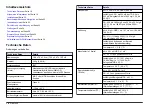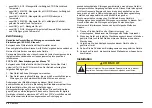
Supporting test records reside with the manufacturer.
This Class A digital apparatus meets all requirements of the Canadian
Interference-Causing Equipment Regulations.
Cet appareil numérique de classe A répond à toutes les exigences de la
réglementation canadienne sur les équipements provoquant des
interférences.
FCC Part 15, Class "A" Limits
Supporting test records reside with the manufacturer. The device
complies with Part 15 of the FCC Rules. Operation is subject to the
following conditions:
1.
The equipment may not cause harmful interference.
2.
The equipment must accept any interference received, including
interference that may cause undesired operation.
Changes or modifications to this equipment not expressly approved by
the party responsible for compliance could void the user's authority to
operate the equipment. This equipment has been tested and found to
comply with the limits for a Class A digital device, pursuant to Part 15 of
the FCC rules. These limits are designed to provide reasonable
protection against harmful interference when the equipment is operated
in a commercial environment. This equipment generates, uses and can
radiate radio frequency energy and, if not installed and used in
accordance with the instruction manual, may cause harmful interference
to radio communications. Operation of this equipment in a residential
area is likely to cause harmful interference, in which case the user will be
required to correct the interference at their expense. The following
techniques can be used to reduce interference problems:
1.
Disconnect the equipment from its power source to verify that it is or
is not the source of the interference.
2.
If the equipment is connected to the same outlet as the device
experiencing interference, connect the equipment to a different
outlet.
3.
Move the equipment away from the device receiving the interference.
4.
Reposition the receiving antenna for the device receiving the
interference.
5.
Try combinations of the above.
Installation
C A U T I O N
Multiple hazards. Only qualified personnel must conduct the tasks
described in this section of the document.
Install the batteries
W A R N I N G
Explosion hazard. Incorrect battery installation can cause the release of explosive
gases. Be sure that the batteries are of the same approved chemical type and
are inserted in the correct orientation. Do not mix new and used batteries.
N O T I C E
The battery compartment is not waterproof. If the battery compartment becomes
wet, remove and dry the batteries and dry the interior of the compartment. Check
the battery contacts for corrosion and clean them if necessary.
N O T I C E
When using nickel metal hydride (NiMH) batteries, the battery icon will not
indicate a full charge after freshly charged batteries have been inserted (NiMH
batteries are 1.2 V versus 1.5 V for alkaline batteries). Even though the icon does
not indicate complete charge, 2300 mAH NiMH batteries will achieve 90% of
instrument operation lifetime (before recharge) versus new alkaline batteries.
N O T I C E
To avoid potential damage to the meter from battery leakage, remove the meter
batteries prior to extended periods of non-use.
The meter can be powered with AA alkaline or rechargeable NiMH
batteries. To conserve battery life, the meter will power off after
5 minutes of inactivity. This time can be changed in the Display Options
menu.
English
5
Summary of Contents for sensION+ EC5
Page 194: ...TDS 0 00 o 4 44 0 64 5 CE 194...
Page 196: ...1 2 3 4 5 NiMH NiMH 1 2 V 1 5 V 2300 mAH NiMH 90 NiMH AA 5 Display Options 196...
Page 197: ...1 IP67 1 1 2 2 2 197...
Page 198: ...3 1 4 2 5 3 3 4 pH1 1 pH ORP 4 2 5 3 198...
Page 199: ...5 DO6 1 DO 4 2 5 3 6 MM110 1 pH 4 2 5 3 6 ORP 199...
Page 200: ...7 MM150 1 5 2 pH 6 3 7 TDS ORP 4 8 8 MM156 1 5 2 pH 6 3 7 DO 4 8 200...
Page 201: ...9 EC5 1 4 2 5 3 6 TDS 5 MSDS pH pH ORP 201...
Page 203: ...1 2 3 4 5 6 pH 7 pH 8 9 10 11 1 2 pH ORP 1 2 3 pH ORP mV pH ORP 1 2 3 OFF 203...
Page 205: ...5 1 2 OFF 3 OFF 1 2 2 3 3 2 205...
Page 206: ...10 10 E1 206...
Page 207: ...E2 250 nA E2 pH 70 105 E2 30 E3 0 05 1 207...
Page 208: ...E3 58 mV E4 E4 TC 0 E5 E6 ErA MM156 50 g L 208...
Page 259: ...0 00 4 44 0 64 5 CE 259...
Page 261: ...2 3 4 5 NiMH NiMH 1 2 1 5 NiMH 2300 90 NiMH 5 261...
Page 262: ...1 IP67 1 1 2 2 2 3 1 4 2 5 3 262...
Page 263: ...3 4 pH1 1 pH 4 2 5 3 5 DO6 1 4 2 5 3 263...
Page 264: ...6 MM110 1 pH 4 2 5 3 6 7 MM150 1 5 2 pH 6 3 7 4 8 264...
Page 265: ...8 MM156 1 5 2 pH 6 3 7 4 8 9 EC5 1 4 2 5 3 6 265...
Page 266: ...5 MSDS pH pH 5 10 5 15 45 15 6 1 2 1013 SAL NaCl 0 Aut MM156 SEn DO 5120 5130 3 274 266...
Page 269: ...5 6 85 C 2 1 2 C F 5 1 2 OFF no 3 OFF 1 2 2 3 3 2 269...
Page 270: ...10 10 E1 270...
Page 271: ...E2 250 E2 pH 70 105 E2 30 E3 0 05 1 271...
Page 272: ...E3 58 E4 E4 TC 0 TC E5 E6 ErA MM156 50 TC 272...
Page 275: ...3 NaCl 33 6 20 2 41 2 25 4 48 9 30 6 56 3 35 8 62 2 40 0 69 4 45 3 75 7 50 0 275...
Page 338: ...TDS 0 00 4 44 0 64 5 CE 338...
Page 340: ...3 4 5 NiMH NiMH 1 2 V 1 5 V 2300 mAH NiMH 90 NiMH 5 340...
Page 341: ...1 IP67 1 1 2 2 2 3 1 4 2 5 ON OFF 3 341...
Page 342: ...3 Measure Calibration Standby 4 pH1 1 pH ORP 4 2 5 3 5 DO6 1 DO 4 2 5 3 342...
Page 343: ...6 MM110 1 pH 4 2 5 3 6 ORP 7 MM150 1 5 2 pH 6 3 7 TDS ORP 4 8 343...
Page 344: ...8 MM156 1 5 2 pH 6 3 7 4 8 9 EC5 1 4 2 5 3 6 TDS 344...
Page 348: ...5 6 85 C 2 1 2 C F 5 1 2 OFF no 3 OFF 1 2 2 3 3 2 348...
Page 349: ...10 10 E 1 349...
Page 350: ...E 2 250 mA E 2 pH 70 105 E2 30 E3 0 05 cm 1 350...
Page 351: ...E3 58 mV E4 E4 TC 0 TC E5 E6 ErA MM156 50 g L TC 351...
Page 354: ...3 mS cm g L NaCl 56 3 35 8 62 2 40 0 69 4 45 3 75 7 50 0 354...
Page 386: ......
Page 387: ......




















